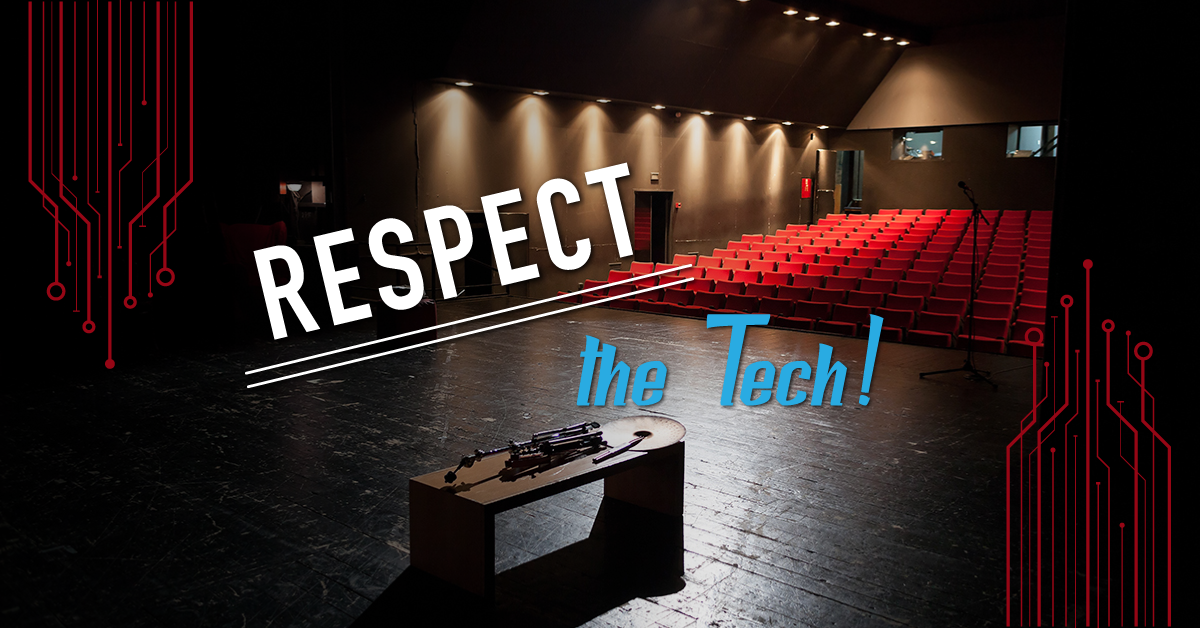A squirt gun would never be mistaken for a real gun, right? Dive into the thought-provoking world of Water. Gun. Argument and challenge what we choose to believe. A thought provoking and powerful piece in a docu-theatre style.
How to Run a Tech Challenge in the Drama Classroom
Have you heard of Tech Challenge (sometimes it’s called Tech Olympics)? Teams compete in common tasks that every technician should know and/or participate in during the run of a show. Some examples include hanging and focusing a light, taping out a groundplan, doing a prop shift, doing a costume quick change, or setting up a sound system. Many thespian festivals include a tech challenge as part of their schedule which makes for a nice balance of onstage and offstage activities. Onstage actors often get all the accolades for a show even though any production is always a group effort of onstage and offstage team members. A Tech Challenge puts tech crews in the spotlight.
How can you use this in your classroom?
After you take your students through the definitions of the backstage roles (eg: stage manager, lighting operator, costume designer, stage crew), put the following two tech tasks into action: Costume Quick Change, and Prop Shift.
(Note: I resourced the information regarding the Costume Quick Change and the Props Shift from four Thespian websites: Georgia Thespians, Texas Thespians, Kansas Thespians (they have score sheets), and Nebraska Thespians.)
Costume Quick Change
1. Identify the definition of a costume quick change.
- To help an actor get out of one costume and into another costume in a limited period of time – sometimes quick changes have to take place in under a minute!
- Emphasize to students how important the costume quick change is to the show’s success. Emphasize how backstage roles connect to onstage roles. Everyone is part of the same community.
- Find online examples of costume quick changes to show students what a quick change looks like. Search for “Quick Change” on YouTube. Here’s one from Mary Poppins and one from The Wizard of Oz. Point out to students how the actor stands/helps during the quick change. Note that each dresser has a specific job and that no one is frantic during the quick change.
2. Explain to students that they are going to run through a costume quick change in small groups.
3. Show students the two costumes each group is going to use to during the quick change. Both costumes should include pieces that go from head to toe. For example:
- Costume one: Baseball hat, t-shirt, jacket, pants, belt, running shoes.
- Costume two: fedora hat, dress shirt, jacket, tie, suspenders, dress pants, dress shoes.
These are just examples – modify the costumes to fit what you have available. Just make sure that each costume is a complete head to toe set.
4. As a class, identify the step by step actions needed in a costume quick change. What are the most efficient steps when changing between two costumes? If there are a couple of dressers, what can each do to make the change quicker? You could even go through the change slowly as a model to try out different suggestions.
5. Divide the class into small groups. Each group will complete the Costume Quick Change as follows:
- Gather at the start/end area. Put a line of tape on the ground to identify when the stopwatch person starts the watch and when they stop.
- Move to the costume quick change area
- Help actor out of costume one
- Help actor into costume two
- Hang up costume one
- Move back to the designated start/end area
Identify that everything must be properly undone on costume one and refastened for costume two. (Meaning, you can’t just rip off the shirt for costume one or leave a shirt unbuttoned for costume two, to save time.)
Note: The actor is allowed to help (unbutton a shirt, slip out of shoes), but only at the request of the techs.
6. Each group will compete for time. Give each group a copy of the Costume Quick Change Info Sheet (see button below for the free download!). Each penalty adds time to the final score. Penalties include:
- Any items not properly placed on actor (eg: shirt left unbuttoned) – 10 seconds per item
- Missing hat/tie – 15 seconds per item
- Unnecessary roughness of the actor – 5 seconds
- Rude treatment of actor – 15 seconds
- Costume 1 outfit not hung up or not placed on hangers properly – 5 seconds
- Dropping hangers or other items during the change – 5 seconds per occurrence
- Blatant disregard for the rules – disqualification
7. Give groups time to discuss their strategy and practice. Don’t let groups practice with the actual costumes/pieces they will use during the challenge.
8. Each group completes the Costume Quick Change. Have someone monitor the stopwatch so that you can pay attention to the change. Watch the change to identify if any of the penalties occur. The timer will start the stopwatch when the group leaves the start/end area, then stop the watch when the last member of the group reenters the start/end area.
9. Unpack the experience. What was it like to work under a time crunch? What was it like to work together on the change? What went well? What would you change? Can you imagine doing this in a production?
Prop Shift
1. Identify the definition of a Prop Shift.
- To take props offstage at the end of one scene and dress the set as required for the next scene. For example: a table complete with place settings and a tablecloth are removed at the end of Act 1 and is replaced with a different tablecloth and a different set of plates/glasses/cutlery for the top of Act 2.
- Emphasize to students how important the prop shift is to the show’s success. If actors don’t have their props in place, it will affect the scene. Emphasize how backstage roles connect to onstage roles. Everyone is part of the same community.
2. Explain to students that they are going to run through a prop shift in small groups. They are changing an “Act 1” table dressing to an “Act 2” table dressing. They will have a maximum of five minutes to take the items from a table onstage, place them on a prop table offstage, and then re-dress the table onstage with new items. Each table dressing should include:
- tablecloth
- four plates/four glasses/four sets of fork, knife, spoon
- napkins
- centerpiece
The items have to be different for each table dressing, which means that students can’t reuse anything from the first dressed table for the second dressed table.
3. Show the setup to students. Explain that there is a fully dressed table onstage and that those items will need to be placed on a prop table backstage. They will also have to re-dress the table with new items. Ask students to identify what a prop table is and why it’s important backstage. If you google “prop table,” you will come up with images that exactly visualize what a prop table looks like.
4. As a class, identify the step by step actions needed in a prop shift between the two table dressings. What are the most efficient steps? If there are a couple of techs, what can each do to make the change quicker? You could even go through the change slowly as a model to try out different suggestions.
5. Divide the class into small groups. Each group will complete the prop shift for time. Give each group a copy of the Prop Shift Info Sheet (see button below for the free download!). Go through the sheet and identify the rules for the prop shift.
- The timer begins when the group leaves the start/end area and stops when the group returns to the start/end area.
- Students cannot drop props during the change.
- Students cannot place props in their mouths or pockets.
- Students must work quietly as if they are doing the change during a show.
- Students must set the props in their proper place offstage (on the props table).
- Students must place all props properly onstage (the setting cannot be askew!).
- If students reach the end of their 5-minute time limit, they must stop immediately.
6. Identify the penalties for the prop shift competition. Each penalty adds time to the final score. Penalties include:
- Dropping a prop – 10 seconds each time
- Making noise with a prop – 5 seconds
- Carrying a prop in the mouth or pockets – 5 seconds
- Excessive noise during the shift – 5 seconds
- Wrong prop placed on table – 5 seconds per item
- Prop not set properly or carefully onstage – 5 seconds
- Props not set properly offstage – 5 seconds
- Blatant disregard of the rules – disqualification
7. Give groups time to discuss their strategy and practice. Don’t let groups practice with the actual props for the challenge.
8. Each group completes the Prop Shift. Have someone on stop watch so that you can pay attention to the shift. Watch the shift and identify if any of the penalties occur. The timer will start the stopwatch when the group leaves the start/end area, then stop the watch when the last member of the group reenters the start/end area.
9. Unpack the experience. What was it like to work under a time crunch? What was it like to work together on the shift? What went well? What would you change? Can you imagine doing this in a production?



